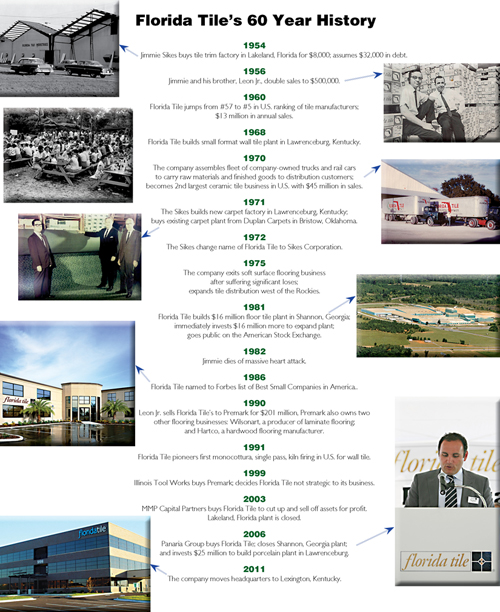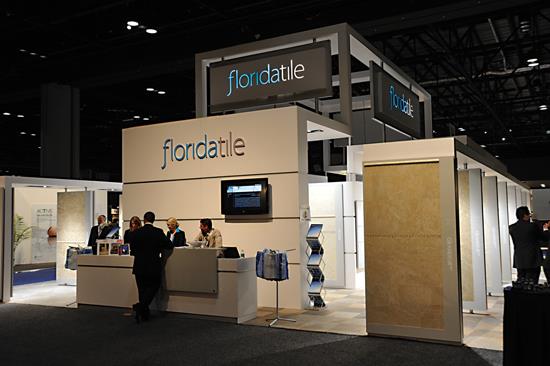Florida Tile Celebrates 60 Years - Aug/Sep 2014
By Kemp Harr
This year marks Florida Tile’s 60th year of business. The company was wrought in the hands of a man who, like many of the best American entrepreneurs, was willing to dream big and take risks. That doesn’t always translate to financial success, and, indeed, Jimmie Sikes had his share of failures. But Jimmie’s spirit of innovation is a large part of why Florida Tile is, today, one of the largest ceramic tile manufacturers in the U.S. market.
In the early 1950s, Leon Sikes, Sr. was a home builder, and the father of two sons, Leon Jr. and James, known as Jimmie. At the time, Leon Sr. was unable to find the specific ceramic trim pieces needed to finish window sills in several of the homes he had in production. When Leon Sr. became debilitatingly sick, his son Jimmie stepped in to source the pieces, which were holding up completion of the properties.
On March 1, 1954, Jimmie visited a tile trim factory in Lakeland, Florida, which produced specialty window sill tiles, and walked out as the owner. He had purchased the plant for $8,000. At the time, it had 16 employees and $32,000 worth of debt.
Following the acquisition, Jimmie focused on sales and marketing, while his brother, Leon Jr., managed operations. After only two years of ownership, the brothers had doubled the company’s sales and achieved profitability.
In 1960, the company advanced from a ranking of 57th to fifth in sales volume among U.S. tile producers, and in 1961, Florida Tile’s stock jumped from less than $0.50 per share to over $6.00 per share.
Buoyed by this success, in 1968, the brothers opened a wall tile factory in Lawrenceburg, Kentucky that produced 41/4” wall tile. At the time, wall tile accounted for almost 80% of all tile sold in the U.S., and the 20% of tile sold for floor use was primarily installed in bathrooms. By the end of the 1960s, however, Jimmie became concerned that the tile business was stagnant and believed that further success would come through diversification. Acting on this belief, in 1971, he built a carpet plant in Lawrenceburg—a building that today serves as Florida Tile’s distribution center.
The company’s first foray into soft surface flooring was a success. The indoor/outdoor product with foam latex backing was innovative enough to be copied by several other firms. Based on the success of its first product, the Sikes bought a second, already-existing carpet plant in Bristow, Oklahoma. However, the company’s success in the carpet business quickly turned, and after losing $13 million in 1975 alone, the company took leave of the soft surface flooring business.
Reeling from this failure, Jimmie took a trip to Italy, a trip that renewed his enthusiasm and vision for the tile business. He returned to the U.S. and developed a five-year plan for the business, part of which included building a red-body glazed floor tile plant.
In 1981, Jimmie selected Shannon, Georgia as the site for this plant based on its proximity to raw materials. The initial investment for the facility was $16 million. When completed, the Shannon facility operated the first monocottura (single-pass firing) tile line in the U.S. The product manufactured in the Shannon facility was so popular that the plant was expanded every year for the next seven years, and, in 1986, Forbes Magazine named Florida Tile one of the best small companies in America.
Unfortunately, however, Jimmie didn’t live to see that success. He died of a massive heart attack in 1982, before the plant in Shannon was completed.
Leon Jr. waited eight years. Then, in June 1990, he sold Florida Tile for $201 million, double its worth, to Premark International. In 1999, Illinois Tool Works (ITW) bought Premark with a stock purchase; determined that tile manufacturing was not part of its core competency; and, in November 2003, sold Florida Tile to MMP Capital Partners. MMP’s plan was to exit the tile business, selling off the real estate and other assets for a profit. To that end, Florida Tile CEO Matt Galvez shut down the original tile plant in Lakeland, Florida in 2004.
However, at the time, the Italian Panaria Group was looking to expand into the U.S. market and, in 2006, purchased Florida Tile from MMP, recognizing the advantage of acquiring the well-known brand name, along with its existing distribution network.
The Panaria Group—worth about $500 million at the time—then decided to invest $25 million to convert Florida Tile’s Lawrenceburg wall tile factory into a porcelain factory outfitted with the latest Italian-made processing equipment. The plant was opened in 2007, and, in the years since the Panaria acquisition, Florida Tile has doubled its sales. In 2013, Florida Tile was the fourth largest ceramic tile producer in the U.S. with sales of $92 million.
More than three decades after his death, Jimmie Sikes is still considered the visionary behind Florida Tile, responsible for the company’s experimental pursuits and its early success. In fact, several of the most successful distributors in the market today got their start selling tile for Jimmie.
|
FLORIDA TILE'S INNOVATIVE LEADERSHIP |
|
• First monocottura tile line in the U.S. |

Copyright 2014 Floor Focus
Related Topics:RD Weis
